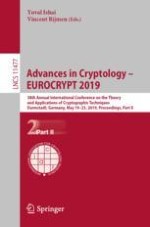Abstract
A fundamental problem in the theory of secure multi-party computation (MPC) is to characterize functions with more than 2 parties which admit MPC protocols with information-theoretic security against passive corruption. This question has seen little progress since the work of Chor and Ishai (1996), which demonstrated difficulties in resolving it. In this work, we make significant progress towards resolving this question in the important case of aggregating functionalities, in which m parties \(P_1,\dots ,P_m\) hold inputs \(x_1,\dots ,x_m\) and an aggregating party \(P_0\) must learn \(f(x_1,\dots ,x_m)\).
We uncover a rich class of algebraic structures that are closely related to secure computability, namely, “Commuting Permutations Systems” (CPS) and its variants. We present an extensive set of results relating these algebraic structures among themselves and to MPC, including new protocols, impossibility results and separations. Our results include a necessary algebraic condition and slightly stronger sufficient algebraic condition for a function to admit information-theoretically secure MPC protocols.
We also introduce and study new models of minimally interactive MPC (called UNIMPC and

), which not only help in understanding our positive and negative results better, but also open up new avenues for studying the cryptographic complexity landscape of multi-party functionalities. Our positive results include novel protocols in these models, which may be of independent practical interest.
Finally, we extend our results to a definition that requires UC security as well as semi-honest security (which we term strong security). In this model we are able to carry out the characterization of all computable functions, except for a gap in the case of aggregating functionalities.
 ), which not only help in understanding our positive and negative results better, but also open up new avenues for studying the cryptographic complexity landscape of multi-party functionalities. Our positive results include novel protocols in these models, which may be of independent practical interest.
), which not only help in understanding our positive and negative results better, but also open up new avenues for studying the cryptographic complexity landscape of multi-party functionalities. Our positive results include novel protocols in these models, which may be of independent practical interest.